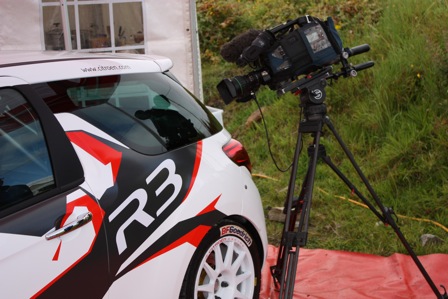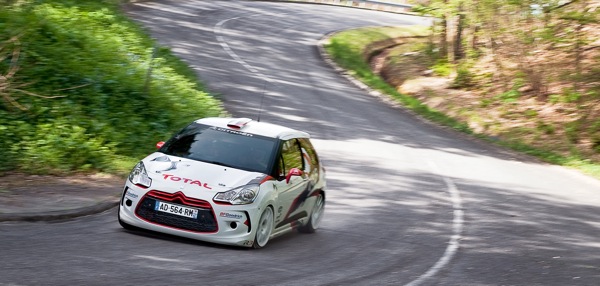 Rally ChampionshipsIrish Rally ChampionshipsNight NavOther Rally Championships2021 CalendarWorld Rally ChampionshipAutocrossRallycrossHillclimb, Autotest, EnduranceHillclimb |
Photos: Pre Ulster Citroen DS3 R3 TestPosted: August 18, 2010 9:28 PM - 8578 Hits

CITROËN DS3 R3: THE NEW STANDARDPosted: July 3, 2010 12:41 PM
In addition to Citroën Racing’s official participation in WRC, where it has won five FIA World Championship Constructors’ titles, Citroën Racing has always offered products designed for customers. The champion team has now furthered this rich tradition with Citroën DS3 R3, a model set to make its rallying debut at the end of 2010. Versatile, high performance and yet affordably-priced, DS3 R3 is set to become the new leader in its category.
- The lower, frontally-offset anchor point helps increase the travel and the guiding length of the shock absorber. At the rear, the production cross-member has been reinforced and altered to make it easier to fit the anti-roll bar. The removable rear wheel hubs allow the camber and toe settings to be adjusted independently. The braking system features a ‘pedal box’ assembly with two master cylinders. The discs are held in place by four-calliper pistons at the front and two-calliper pistons at the rear. The handbrake is hydraulic. ENGINE: A 1.6-LITRE HIGH-PRESSURE TURBO WITH INCREDIBLE TORQUE For the first time ever, Citroën Racing has produced a customer-racing product fitted with a turbocharged engine. The experience acquired by the brand in WRC for almost ten years has been put to good use in its design. The 1.6-litre THP (high pressure turbo) engine is very closely related to the production model used throughout the PSA Group. Fitted with a regulation-compliant 29mm turbo flange, it develops 210bhp of power and generates a torque of 350Nm (with commercially available fuel). This second value improves traction and delivers excellent versatility at all engine speeds. In accordance with the regulations, many parts have been taken or derived from the production model. For example, the intake and exhaust manifolds, turbocharger, injectors and injection pumps are identical to those used on production models. The air filter, camshaft, pistons, connecting rods and engine flywheel are, however, specific racing parts. To avoid oil surges during long corners and to increase ground clearance, the oil sump has been altered and fitted with a composite partition. The exhaust and turbocharger system is also specific; the catalytic converter is similar to the one used on C4 WRC. DS3 R3’s engine ECU also includes a data acquisition system that is able to check a large number of parameters. GEARBOX: A MAJOR FIRST WITH SEMI-AUTOMATIC CONTROL One of the main innovations on DS3 R3 concerns its gearbox. For the first time, a customer-racing product has been fitted with a semi-automatic gearbox, which reduces the time spent changing gears and increases reliability. The electronic management system only authorises gear changes when the engine parameters allow it. Once again, the expertise developed by Citroën Racing in WRC enabled this cutting-edge technology to be adapted to DS3 R3. Inside the cabin, the composite fibre steering wheel-mounted paddles are just as ergonomic as on C4 WRC: the driver flicks the paddle backwards to move up the gears and flicks it forwards to move down the gears. The clutch pedal is still present, but is only used to drive off. During subsequent gear changes, the clutch is automatically controlled. Under the bonnet, the specific elements of the semi-automatic control (solenoid valves, actuators and pressure unit) have all been taken from the production model and adapted to the six-speed gearbox. The housing for the twin-disc clutch has been cast in aluminium, whilst the gearing casing has been cut from the block. DEVELOPMENT: OVER 10,000KM OF TESTING After twelve months spent in Citroën Racing’s design office, DS3 R3 made its first outing at the end of August 2009. To check the sturdiness of the various components, initial testing was carried out on ‘rough gravel’ test tracks, typical of the road surfaces seen in Mediterranean rallies. Development testing continued on tarmac, the ideal surface to test performance, and on flowing gravel roads. In total, DS3 R3 covered over 10,000km in development testing, split evenly among the different types of road surfaces. Several drivers took part in the tests. They all had varying levels of experience, different preferences and driving styles, which meant that the engineers could accumulate data that will benefit future DS3 R3 owners. All of the drivers agreed that the car was easy to drive and highlighted three strengths: the torque of the 1.6-litre engine, the semi-automatic gearbox and the suspension. DS3 R3 offers impressive performance levels and looks set to become the new leader in its category in rallying.
Topics:
Cars
|
|

 News Stories
News Stories Classifieds
Classifieds Shop
Shop TV Guide
TV Guide Links
Links Upcoming
Upcoming 

 Most
Most